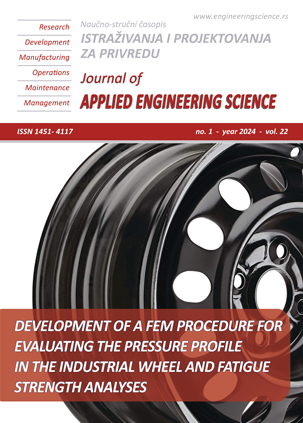ENHANCING S45C STEEL FOR THE PRIMARY COMPONENT OF AN AUTOMATIC COUPLER USING QUENCH-TEMPERING TECHNIQUES
Abstract
Coupling links and hooked plates constitute the primary components of automatic couplers in trains, enduring substantial tensile and compressive loads during train connections. This study endeavours to enhance the strength of S45C material through heat treatment techniques. The research commenced with the preparation of JIS S45C tensile test specimens adhering to ASTM E8 standards. The material's chemical composition was validated using an Optical Emission Spectrometer (OES). Six heat treatment variations were employed, including quench oil without tempering (QO), quenching water without tempering (QW), quenching oil tempered at 660°C (QOT660), quenching water tempered at 660°C (QWT660), quenching oil tempered at 550°C (QOT550), quenching water tempered at 550°C (QWT550), alongside untreated conditions (NT) for comparison. The efficacy of heat treatment was evaluated through tensile testing, optical metallographic analysis, and micro-Vickers hardness tests. QO and QW scenarios were excluded from the tensile tests. Results revealed that QWT550 demonstrated the most substantial enhancement in material yield, exhibiting a 115% increase. Moreover, hardness testing indicated superior hardness in QWT550 specimens compared to other tempered variants. The metallographic analysis illustrated the formation of identical and smooth martensitic structures. Overall, the combination of cooling heat treatment and tempering proved sufficient to meet the design requirements of hooked plates and coupling links for automatic couplers.
References
Chunduru, S. P., Kim, M. J., & Mirman, C. (2011). Failure analysis of railroad couplers of AAR type E. Engineering Failure Analysis, 18(1), 374–385.
Huang, J., Xia, L., Zhang, Y., & Li, S. (2014). Investigation on brittle fracture mechanism of a grade E cast steel knuckle. Case Studies in Engineering Failure Analysis, 2(1), 15–24.
Steed, J. (2015). Improving the 10" Head Alliance Coupler and Knuckle. Ihha 2015, (June).
Morsy, M. A., Khafagy, S., & Mosa, E. S. (2019). Failure Analysis of the Semi-permanent Coupler Used in Metro Rail. IOP Conference Series: Materials Science and Engineering, 611(1).
Valentino, J. M., Pramono, A. S., & Syaifudin, A. (2022). Design Optimization of Hooked Plate on the Automatic Coupler for High-Speed Train. Recent Advances in Mechanical Engineering, 10–18.
British Standard Institution (2014). BS EN 16019:2014 Railway applications Automatic Coupler Performance requirements, specific interface geometry and test method.
Pimenov, D. Y., Abbas, A. T., Gupta, M. K., Erdakov, I. N.& Soliman, M. S (2020). Investigations of surface quality and energy consumption associated with costs and material removal rate during face milling of AISI 1045 steel. International Journal of Advanced Manufacturing Technology, 107(7–8), 3511–3525.
Deldar, S., Smaga, M., Beck,T. (2022). On the influence of cyclic loadings on the magnetic permeability of ferritic-pearlitic AISI 1045 steel. International Journal of Fatigue, 159.
Singh, S., Samir, S., Kumar, K., & Thapa, S. (2021). Effect of heat treatment processes on the mechanical properties of AISI 1045 steel. Materials Today: Proceedings, 45, 5097–5101.
Totten, G. E. (2006). Steel heat treatment. Steel Heat Treatment: Metallurgy and Technologies, 277–414.
Vieira, E. da R., Biehl, L. V., Medeiros, J. L. B., Costa, V. M., & Macedo, R. J. (2021). Evaluation of the characteristics of an AISI 1045 steel quenched in different concentrations of polymer solutions of polyvinylpyrrolidone. Nature Scientific Reports, 11(1), 1–8.
Li, Y. et al., (2023).Effects of process parameters on the microstructure and mechanical properties of AISI 1045 steel prepared by selective laser melting. Material Today Communications, 37.
Chuaiphan, W., Srijaroenpramong, L., & Pinpradub, D. (2013). The effects of heat treatment on microstructure and mechanical properties of AISI 4140 for base cutter cane harvester. Advanced Materials Research, 774–776, 1059–1067.
Terasaki, H., Shintome, Y., Takada, A., Komizo, Y., & Morito, S. (2015). In-situ characterization of martensitic transformation in high carbon steel under continuous-cooling conditions. Materials Today: Proceedings, 2, S941–S944.
Song, Y.H., Tane, M., Nakajima,H. (2012). Dynamic and quasi-static compression of porous carbon steel S30C and S45C with directional pores. Material Science and Engineering A, 534, 504–513.
Hoyos, J. J., Ghilarducci, A. A., Salva, H. R., Chaves, C. A. (2011). Effects of tempering on internal friction of carbon steels. Material Science and Engineering A, 528, 3385–3389.
Clarke, A. J., Klemm-Toole, J., Clarke, K. D., Coughlin, D. R., Pierce, D. T., Euser, V. K., Krauss, G. (2020). Perspectives on Quenching and Tempering 4340 Steel. Metallurgical and Materials Transactions A: Physical Metallurgy and Materials Science, 51(10), 4984–5005.
Nunura, C. R. N., dos Santos, C. A., & Spim, J. A. (2015). Numerical - Experimental correlation of microstructures, cooling rates and mechanical properties of AISI 1045 steel during the Jominy end-quench test. Materials and Design, 76, 230–243.
Phi, L. N. N., Thien, N. D., Le Chi, C., Vinh, P. N. (2018). Solution for Heat Treatment in Quenching Process of S45C Steel Small Diameter Machine Parts Having Strong Texture. 4th International Conference on Green Technology and Sustainable Development, 241–245.
Moćko, W. (2014). The influence of stress-controlled tensile fatigue loading on the stress-strain characteristics of AISI 1045 steel. Material and Design, vol. 58, pp. 145–153, 2014.
Akhyar, I., & Sayuti, M. (2015). Effect of Heat Treatment on Hardness and Microstructures of AISI 1045. Advanced Materials Research, 1119, 575–579.
Jo, H., Kang, M., Park, G. W., Kim, B. J., Choi, C. Y., Park, H. S., Jeon, J. B. (2020). Effects of cooling rate during quenching and tempering conditions on microstructures and mechanical properties of carbon steel flange. Materials, 13(18).
Yazdania, S., Yoozbashi, N., & Ebrahimi, A. (2007). Enhancement of Fatigue Strength of SAE 1045 Steel by Tempering Treatment and Shot Peening. Material Science Forum, vol. 561–565, pp. 41–44.
ASTM. (2013). Standard test methods for tension testing of metallic materials E8/E8M. In Annual Book of ASTM Standards 4.
British Standard Institution (1999) Heat Treatment EN 10083-1. p. 10083.
Cabezas, E. E., & Celentano, D. J. (2004). Experimental and numerical analysis of the tensile test using sheet specimens. Finite Elements in Analysis and Design, 40(5–6), 555–575.
Tabatabae, B. A., Ashrafizadeh, F., & Hassanli, A. M. (2011). Influence of retained austenite on the mechanical properties of low carbon martensitic stainless steel castings. ISIJ International, 51(3), 471–475.

